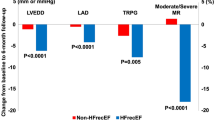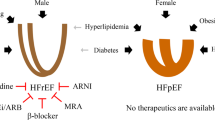Abstract
The management of patients with congestive heart failure (CHF) is challenging and the mortality with medical therapy alone is high. Left ventricular dilatation represents one of the strongest predictors of mortality in CHF, and a variety of surgical interventions have been proposed over the years to reverse ventricular remodeling. The most common surgical methods currently used are myocardial revascularization, left ventricular restoration, mitral valve repair, surgical ablation of atrial fibrillation, and employment of diastolic support and ventricular assist devices. In many patients a combination of these procedures is required to address the multiple pathophysiologic components of CHF. As techniques are refined and more data become available, the results of surgical treatment of heart failure are likely to improve. In addition, advances in innovations such as gene therapy, cell therapy and engineered artificial myocardial tissue will hopefully bring additional benefits to this problematic therapy over the next few years. In this review we discuss the characteristics of the most common surgical techniques for reversing left ventricular remodeling.
Key Points
-
Mortality is high among patients with congestive heart failure who are treated with medical therapy alone
-
The severity of left ventricular dilatation and remodeling represents one of the strongest predictors of mortality
-
Myocardial revascularization, left ventricular restoration, mitral valve repair, surgical ablation of atrial fibrillation, and diastolic support and ventricular assist devices represent the most common current surgical therapies for reversal of ventricular remodeling
-
Most surgical approaches yield notable improvements in terms of symptoms and quality of life
-
Trials assessing survival benefit are ongoing
This is a preview of subscription content, access via your institution
Access options
Subscribe to this journal
Receive 12 print issues and online access
$209.00 per year
only $17.42 per issue
Buy this article
- Purchase on Springer Link
- Instant access to full article PDF
Prices may be subject to local taxes which are calculated during checkout

Similar content being viewed by others
References
Pieske B (2004) Reverse remodeling in heart failure—fact or fiction? Eur Heart J 6 (Suppl D): S55–S78
Pfeffer MA et al. (1992) Effect of captopril on mortality and morbidity in patients with left ventricular dysfunction after myocardial infarction: results of the survival and ventricular enlargement trial. The Save Investigators. N Engl J Med 327: 669–677
Cohn JN (1995) Structural basis for heart failure. Circulation 91: 2504–2507
Alfieri O et al. (1993) Recovery of myocardial function: the ultimate target of coronary revascularization. Eur J Cardiothorac Surg 7: 325–330
Bax JJ et al. (2001) Relationship between preoperative viability and postoperative improvement in LVEF and heart failure symptoms. J Nucl Med 42: 79–86
Bax JJ et al. (1999) Improvement of left ventricular ejection fraction, heart failure symptoms and prognosis after revascularization in patients with chronic coronary artery disease and viable myocardium detected by dobutamine stress echocardiography. J Am Coll Cardiol 34: 163–169
Di Carli MF et al. (1995) Quantitative relation between myocardial viability and improvement in heart failure symptoms after revascularization in patients with ischemic cardiomyopathy. Circulation 92: 3436–3444
Allman KC et al. (2002) Myocardial viability testing and impact of revascularization on prognosis in patients with coronary artery disease and left ventricular dysfunction: a meta-analysis. J Am Coll Cardiol 39: 1151–1158
Rizzello V et al. (2004) Opposite patterns of left ventricular remodeling after coronary revascularization in patients with ischemic cardiomyopathy: role of myocardial viability. Circulation 110: 2383–2388
Mule J et al. (2002) The beneficial effect of revascularization on jeopardized myocardium: reverse remodeling and improved long-term prognosis. Eur J Cardiothorac Surg 22: 426–430
Bax JJ et al. (2004) Extensive left ventricular remodeling does not allow viable myocardium to improve in left ventricular ejection fraction after revascularization and is associated with worse long-term prognosis. Circulation 110 (Suppl II): SII18–SII22
Yamaguchi A et al. (1998) Left ventricular volume predicts postoperative course in patients with ischemic cardiomyopathy. Ann Thorac Surg 65: 434–438
McCarthy PM (1999) New surgical options for the failing heart. J Heart Valve Dis 8: 472–475
Dor V (2001) The endoventricular circular patch plasty (“Dor procedure”) in ischemic akinetic dilated ventricles. Heart Fail Rev 6: 187–193
Kramer CM et al. (2002) Reverse remodeling and improved regional function after repair of left ventricular aneurysm. J Thorac Cardiovasc Surg 123: 700–706
Schenk S et al. (2004) Neurohormonal response to left ventricular reconstruction surgery in ischemic cardiomyopathy. J Thorac Cardiovasc Surg 128: 38–43
Athanasuleas CL et al. (2004) Surgical ventricular restoration in the treatment of congestive heart failure due to post-infarction ventricular dilation. J Am Coll Cardiol 44: 1439–1445
Castiglioni A et al. (2002) Surgical restoration of the left ventricle for postinfarction aneurysm. Ital Heart J 3: 370–374
Koelling TM et al. (2002) Prognostic significance of mitral regurgitation and tricuspid regurgitation in patients with left ventricular systolic dysfunction. Am Heart J 144: 524–529
Trichon BH et al. (2003) Relation of frequency and severity of mitral regurgitation to survival among patients with left ventricular systolic dysfunction and heart failure. Am J Cardiol 91: 538–543
Robbins JD et al. (2003) Prevalence and severity of mitral regurgitation in chronic systolic heart failure. Am J Cardiol 91: 360–362
Wu AH et al. (2005) Impact of mitral valve annuloplasty on mortality risk in patients with mitral regurgitation and left ventricular systolic dysfunction. J Am Coll Cardiol 45: 381–387
Bolling SF et al. (2005) Reforming LV geometry in CHF with MR: a unique valvular solution for a ventricular problem [abstract #T2]. In American Association for Thoracic Surgery, 85th Annual Meeting Abstract Book: 2005 April 10–13; San Francisco, CA, 216; AATS: Beverly, MA
De Bonis M et al. (2005) Mitral valve repair for functional mitral regurgitation in end-stage dilated cardiomyopathy: role of the “Edge-to-Edge” technique. Circulation 112 (Suppl I): SI402–SI408
Tibayan FA et al. (2004) Undersized mitral annuloplasty alters left ventricular shape during acute ischemic mitral regurgitation. Circulation 110 (Suppl 1): SII98–SII102
Bolling SF et al. (2001) Surgical alternatives for heart failure. J Heart Lung Transplant 20: 729–733
Bax JJ et al. (2004) Restrictive annuloplasty and coronary revascularization in ischemic mitral regurgitation results in reverse left ventricular remodeling. Circulation 110 (Suppl 1): SII103–SII108
Acker MA et al. (2005) Mitral valve surgery in heart failure: results of the Acorn CorCapTM randomized trial [abstract #1]. In American Association for Thoracic Surgery, 85th Annual Meeting Abstract Book: 2005 April 10–13; San Francisco, CA, 64; AATS: Beverly, MA
Hung J et al. (2004) Mechanism of recurrent ischemic mitral regurgitation after annuloplasty: continued LV remodeling as a moving target. Circulation 110 (Suppl 1): SII85–SII90
Grossi EA et al. (2005) Intraoperative effects of the coapsys annuloplasty system in a randomized evaluation (RESTOR-MV) of functional ischemic mitral regurgitation. Ann Thorac Surg 80: 1706–1711
Hetzer R et al. (2001) Bridging-to-recovery. Ann Thorac Surg 71 (Suppl): S109–S113
Frazier OH et al. (2004) Mechanical bridging to improvement in severe acute “nonischemic, nonmyocarditis” heart failure. Congest Heart Fail 10: 109–113
Dandel M et al. (2005) Long-term results in patients with idiopathic dilated cardiomyopathy after weaning from left ventricular assist devices. Circulation 112 (Suppl): SI37–SI45
Barbone A et al. (2001) Comparison of right and left ventricular responses to left ventricular assist device support in patients with severe heart failure: a primary role of mechanical unloading underlying reverse remodeling. Circulation 104: 670–675
Bartling B et al. (1999) Myocardial gene expression of regulators of myocyte apoptosis and myocyte calcium homeostasis during hemodynamic unloading by ventricular assist devices in patients with end-stage heart failure. Circulation 100 (Suppl): SII216–SII223
Goldstein DJ et al. (1997) Circulatory resuscitation with left ventricular assist device support reduces interleukins 6 and 8 levels. Ann Thorac Surg 63: 971–974
James KB et al. (1995) Effect of implantable left ventricular device on neuroendocrine activation in heart failure. Circulation 92 (Suppl): SII191–SII195
Yacoub MH (2001) A novel strategy to maximize the efficacy of left ventricular assist device as a bridge to recovery. Eur Heart J 22: 534–540
Anversa P and Nadal-Ginard B (2002) Myocyte renewal and ventricular remodeling. Nature 415: 240–243
Menasche P et al. (2001) Myoblast transplantation for heart failure. Lancet 357: 279–280
Orlic D et al. (2001) Bone marrow cells regenerate infracted myocardium. Nature 410: 701–705
Tomita S et al. (2002) Improved heart function with myogenesis and angiogenesis after autologous porcine bone marrow stromal cells. J Thorac Cardiovasc Surg 123: 1132–1140
Wang JS et al. (2001) The coronary delivery of stromal cells for myocardial regeneration: pathophysiology and therapeutic implications. J Thorac Cardiovasc Surg 122: 699–705
Author information
Authors and Affiliations
Corresponding author
Ethics declarations
Competing interests
The authors declare no competing financial interests.
Rights and permissions
About this article
Cite this article
De Bonis, M., Alfieri, O. Surgery Insight: surgical methods to reverse left ventricular remodeling. Nat Rev Cardiol 3, 507–513 (2006). https://doi.org/10.1038/ncpcardio0631
Received:
Accepted:
Issue Date:
DOI: https://doi.org/10.1038/ncpcardio0631
This article is cited by
-
Ulcerated calcification of the interventricular septum causing Transient Ischemic Attacks: Case Report
Journal of Cardiothoracic Surgery (2007)



